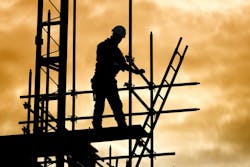10 Tips to Avoid Being an Air Traffic Fatality
A company that makes fall protection devices for sport climbers has a product called an ATC. That stands for air traffic controller, and it’s used by the person on the ground (or ledge) to control the feed and take-up of the rope that attaches to the harness of the climber. Industrial climbers aren’t scaling rock faces with 200-ft ropes, butthey are still subject to being “air traffic.” Follow these tips to avoid becoming airborne — because you usually can’t count on a safe landing.
- Assess the elevation before ascending. What is the No. 1 reason for death or injury while using scaffolding? It may be the same reason that scaffolding violations consistently rank in the Top 10 every year for OSHA citations. Always inspect before going up. If it’s some other kind of platform, look for problems such as missing guardrails, slipping hazards, etc.
- If using a lift, ensure the wheels are locked and the outriggers are correctly deployed — but only after positioning the lift such that any need to reach over the guardrails is minimized and is preferably on the short ends rather than the long sides (to prevent tipping).
- Plan the work to minimize trips up and down. The fewer trips you make up and down a ladder, the safer you are. By the way, ladder violations consistently rank in the Top Ten every year for OSHA citations and usually occupy a spot just above scaffolding violations.
- Correctly use the correct PPE for the task. Inspect your harness and lanyard before walking away from the tool crib (or wherever those are stored). Nets are also considered PPE, so inspect those for proper attachment to correct attachment points. Just because somebody strung a net up for you doesn’t mean it will safely catch you. People have attached these to raceway, process piping, and other items that should never be used as attachment points (same thing with attaching your lanyard).
- Upon arriving at elevation, check it out. Look for loose planks (scaffolding), holes in the floor (e.g., openings for pipes), tripping hazards (that portable cord running three feet from the edge that has no guardrail should probably be moved), and anything else that isn’t right. Resolve these issues before commencing work.
- Pay attention when moving to the work spot. As soon as you leave the ground, focus on what you are doing to get to the platform (or other elevation). Once there, don’t be distracted by a text message, a conversation, activity on the ground, or anything else. Be focused on safely moving yourself to where you will be doing the work.
- Minimize how many tools are out at one time. You have two hands, so there’s no reason to have six tools on the platform bottom for you to trip on. Take a tool from your bucket, pouch, belt, pocket; use it; and then put it back. You want to avoid littering the platform with slipping hazards or things you might kick over the edge onto people below.
- Work methodically. Before climbing to elevation, you should already be familiar with the procedure you’ll use. Once at elevation, follow that procedure. Don’t take shortcuts to save time, as those can easily result in the need to redo something which can mean another trip or two down and back up.
- Clean up as you go. You should have a bucket or other container for scrap, if any scrap will be generated. Lower the bucket before it gets full. Lower your tools before descending.
- Climb down carefully and mindfully. Climbing down is usually harder than climbing up. It’s harder to see your feet, you are likely to be tired from the work you just did, and your mind is tempted to start churning on what comes next. Treat that downclmb as a separate project that deserves your full attention. Place each foot firmly where it needs to go, rather than just stepping casually.
